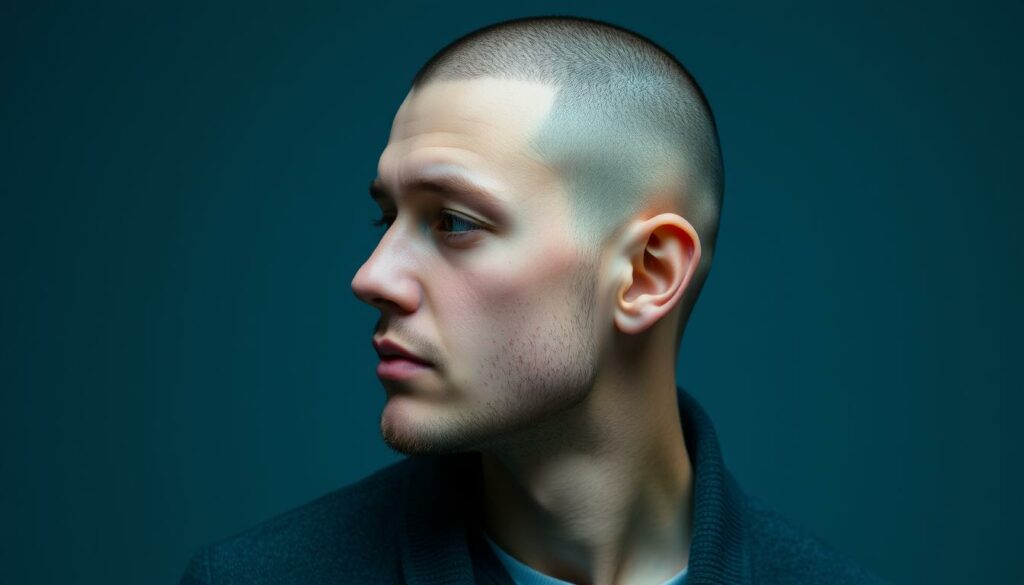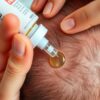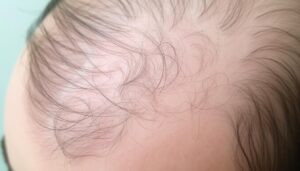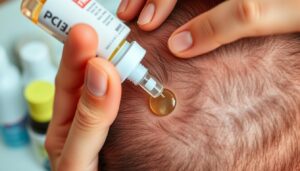Imagine a world where hair loss worries are gone. Over 35 million men in the U.S. deal with male pattern baldness. But, scalp micropigmentation (SMP) has changed how people tackle hair loss. It helps them feel confident again.
This guide will walk you through the key stages of scalp micropigmentation recovery. It offers tips and insights for a smooth healing process. If you’re thinking about scalp micropigmentation or have just had it done, knowing what to expect is key to great results.

Key Takeaways
- Scalp micropigmentation is a groundbreaking solution for hair loss, boosting confidence and giving a natural look.
- The healing process includes initial care, swelling, scabbing, and possible side effects.
- Knowing the healing timeline and following aftercare is vital for the best scalp micropigmentation results.
- Handling concerns like fading or color changes ensures a lasting good result.
- Success stories show how scalp micropigmentation changes lives, offering hope to those with hair loss.
Understanding Scalp Micropigmentation
Scalp micropigmentation is a new way to look better. It puts pigment into your scalp to make it look like you have more hair. It’s great for those dealing with hair loss, thinning, or wanting a new hairline.
What is Scalp Micropigmentation?
This method, also known as good scalp micropigmentation, is a simple, lasting fix for hair issues. A pro puts pigment into your scalp to mimic hair follicles. You get a natural-looking hairline that hides thin spots or bald areas.
Benefits of Scalp Micropigmentation
Scalp micropigmentation makes your hairline look fuller and younger. It’s great for those losing hair due to genes, health issues, or aging. People love it for boosting their confidence and looks.
This method also lasts a long time. Unlike hair fibers or makeup, the pigment stays for years. So, you won’t need to keep coming back for touch-ups.
“Scalp micropigmentation has been a game-changer for me. It’s allowed me to regain my confidence and feel more comfortable in my own skin.”
Scalp Micropigmentation Recovery Timeline
Getting better from scalp micropigmentation takes a few weeks to a few months. This depends on how well you heal and the size of the procedure. We’ll give you a timeline to know what to expect during your recovery journey.
Initial Weeks
Right after your scalp micropigmentation treatment, you might see redness, swelling, and a bit of discomfort. This is normal and will go away in a few days. It’s important to follow what your practitioner tells you to do for the treated area.
Weeks 2-4
As your scalp heals, you might see scabs or crusts. Don’t pick or scratch them. Clean the area gently and use any creams or lotions suggested.
Weeks 4-8
Most of the visible recovery from scalp micropigmentation happens in these weeks. The redness, swelling, and scabs will go away. The color will settle into your skin, showing the final look.
Months 2-4
Healing and settling of the pigment can take a bit longer, up to four months. You might see some fading or color changes. These can be fixed during follow-up treatments.
Remember, everyone heals differently. Always follow your practitioner’s advice and talk about any worries or questions you have.
| Timeline | Typical Stages of Recovery |
|---|---|
| Initial Weeks | Redness, swelling, mild discomfort |
| Weeks 2-4 | Scabbing, crusting |
| Weeks 4-8 | Subsiding of redness, swelling, and scabbing; pigment settling |
| Months 2-4 | Minor fading or color changes; continued pigment settling |
The recovery process for scalp micropigmentation is different for everyone. It’s key to listen to your practitioner for the best results. If you have questions or concerns during recovery, contact your provider.
Immediate Aftercare
Right after your scalp micropigmentation, taking good care of it is key. This means protecting the treated area and handling swelling or redness. Doing this helps your healing go smoothly and gets you the best results from your scalp micropigmentation treatment.
Protecting the Treated Area
Your scalp micropigmentation expert will give you clear instructions on how to care for the treated area right after. You’ll need to clean it gently and use a special ointment or balm to keep the skin moisturized and safe.
Don’t touch or pick at the treated area, as it can mess up the healing and cause problems. Also, stay away from direct sunlight or heat, as they can make things worse.
Managing Swelling and Redness
Swelling and redness are normal after scalp micropigmentation, especially in the first few days. To deal with these, your expert might suggest using cold compresses or anti-inflammatory drugs.
- Cold compresses can lessen swelling and ease discomfort.
- Over-the-counter anti-inflammatory drugs, like ibuprofen, can reduce inflammation and pain.
Always follow your expert’s advice and skip any activities that might bother the treated area during recovery. By being careful, you can make sure your scalp micropigmentation heals well and looks great.
The Healing Process
After your scalp micropigmentation, you might see some side effects like scabbing and crusting. These are normal and we’ll help you manage them. This way, your scalp stays healthy while it heals.
Scabbing and Crusting
Right after your treatment, you might see scabs and crusts on the treated area. This happens because your skin is healing and absorbing the pigment. These scabs and crusts can start within a few days and may last up to two weeks.
Don’t pick or scratch at the scabs, as it can make things worse and lead to bad smp results. Clean the area gently and use a thin layer of recommended ointment or moisturizer. This keeps the skin moist and helps healing.
- Avoid picking or scratching the scabs and crusts
- Gently clean the treated area and apply a thin layer of recommended ointment or moisturizer
- Be patient as the scalp micropigmentation recovery process takes time
When the scabs and crusts fall off, you might see the pigment looking lighter or faded. This is normal and part of healing. The final look will become clear as your skin heals and the pigment settles.
Following good scalp micropigmentation recovery habits is key. This includes following your practitioner’s aftercare advice and avoiding things that could disturb the treated area. Doing this helps ensure a smooth healing process.
Potential Side Effects During Recovery
Most people have a smooth recovery from scalp micropigmentation. But, some might face itching and discomfort during healing. These are common concerns.
Itching and Discomfort
As healing starts, itching or discomfort is normal. The skin is regenerating and the pigment settles in. To ease these issues, patients should:
- Avoid scratching to prevent skin damage and bad results.
- Use a gentle, fragrance-free moisturizer for hydration and itch relief.
- Take over-the-counter pain medication for discomfort.
- Apply a cold compress to reduce inflammation and ease pain.
Itching and discomfort usually go away in a week or two. If they don’t or get worse, talk to the procedure’s practitioner.
Knowing and managing these side effects helps ensure a smooth recovery. This way, patients can avoid scalp micropigmentation regrets or bad SMP outcomes.
Scalp Micropigmentation Recovery Tips
Recovering from a scalp micropigmentation procedure needs care. We’ve put together some tips to help you recover well. These tips will guide you to a successful recovery.
- Follow the aftercare instructions given by your practitioner closely. This means cleaning the area gently, using any suggested ointments, and keeping the scalp out of the sun.
- Let your scalp heal at its own pace. Don’t touch any scabs or crusts as it can mess up the pigment and cause uneven results.
- Use over-the-counter pain relievers or soothing ointments for any discomfort or itching, as your practitioner suggests. But don’t scratch the area to avoid irritation.
- Keep up a healthy lifestyle during recovery. Make sure you rest well, drink plenty of water, and eat a balanced diet to help healing.
- Go for follow-up appointments with your practitioner for any needed touch-ups or adjustments. This ensures your results look consistent and natural.
By using these scalp micropigmentation recovery tips, you can confidently go through the healing process. This will help you achieve a successful and lasting good scalp micropigmentation result.
“Patience and consistent aftercare are the keys to a smooth and satisfactory scalp micropigmentation recovery.” – Jane Doe, Certified Scalp Micropigmentation Specialist
Common Scalp Micropigmentation Recovery Concerns
Going through scalp micropigmentation recovery might bring up worries like pigment fading or color changes. These issues can be scary, but with the right advice, you can handle them. This way, you can keep your results looking natural and consistent.
Dealing with Fading or Color Changes
Fading or color changes in scalp micropigmentation can happen for many reasons. These include sunlight, pigment aging, or the immune system’s response. Remember, some fading is normal and part of healing.
If you see fading or color changes, don’t worry. Here’s what you can do:
- Talk to your scalp micropigmentation expert. They can check the situation and suggest touch-up treatments or changes to the pigment color.
- Keep your scalp out of direct sunlight. Use a hat or sun protection when outside to stop further fading.
- Follow your expert’s aftercare advice closely. Good care can make your scalp micropigmentation last longer.
By taking action early, you can keep your scalp micropigmentation looking confident and natural. It will help with your hair loss or thinning issues.
| Concern | Description | Possible Causes | Recommended Actions |
|---|---|---|---|
| Fading Pigment | The pigment applied during the scalp micropigmentation procedure gradually fades over time. |
|
|
| Color Changes | The pigment color may shift or change over time, appearing different from the initial application. |
|
|
Remember, dealing with smp regrets or bad smp results is common. But, with the right steps and talking to your scalp micropigmentation expert, you can fix these issues. Positive reviews on scalp micropigmentation often talk about the key of working with skilled pros for a great outcome.
Conclusion
Starting your scalp micropigmentation journey can be exciting. Come visit Scalpmasters to start that wonderful journey. SMP is a safe and effective way to restore the appearance of a full head of hair or to camouflage baldness or thinning hair. While the length of the procedure can vary depending on the size and complexity of the treatment, most people can expect to spend several hours to a full day in the technician’s chair.
Recovery time after SMP is relatively short, with most people able to resume normal activities within a few days. By following proper aftercare instructions, you can ensure that the treatment heals properly and provides the best possible results.
If you’re interested in SMP, ScalpMasters is here to help. Our team of experienced technicians has helped countless clients achieve a more youthful and attractive look with SMP, and we’re dedicated to providing the highest quality care and support throughout the treatment process. Contact us today to schedule a consultation and learn more about how SMP can transform your appearance and boost your confidence.










